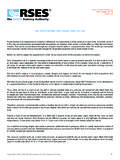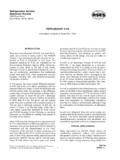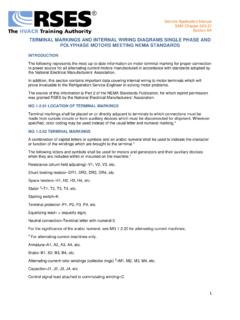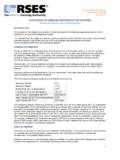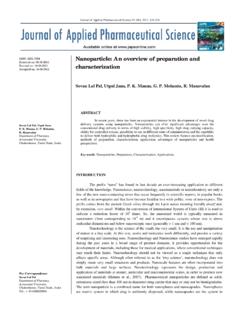Transcription of OIL IN REFRIGERATION SYSTEMS - RSES.org
1 Service Application Manual SAM Chapter 620-107 Section 1A OIL IN REFRIGERATION SYSTEMS INTRODUCTION Until the phaseout of CFC refrigerants, mineral oils were the primary oils used in REFRIGERATION SYSTEMS . However, mineral oils are not suitable for use with the new refrigerants. The main reason for this incompatibility is the insufficient lubricity (lubricating ability) and miscibility(mixing ability) of mineral oils. Much work has been done to find acceptable lubricants to use with the new refrigerants. Synthetic oils such as alkylbenzene and polyolester appear to meet the requirements.
2 As research into new refrigerants continues, so will the search for acceptable lubricants. Synthetic lubricants themselves are not new. They have been used for many years in various industries. As with other oils, lubricants are blended specifically for use in REFRIGERATION SYSTEMS . Until the phaseout of CFC refrigerants, such oils were considered too expensive for general use compared with mineral oil. Oil producers and compressor manufacturers go to great lengths and expense to develop and test new lubricants. There are tests for viscosity, floc point, pour point, flash point, etc.
3 The service engineer does not need to know the details of these oil qualities, but should understand the terms and why they are important. Remember, also, that you should use only the lubricant recommended by the compressor manufacturer. PROPERTIES OF LUBRICATING OILS Lubrication is the separation of moving parts by a film of oil. The closer the parts are to each other that is, the tighter the fit the more emphasis there must be on the role of lubrication. It is safe to say that all high-quality oils lubricate satisfactorily. Then what is so special about oil for REFRIGERATION compressors?
4 How does it differ from other oils? There is, in fact, a big difference. It is described by the following characteristics or properties: viscosity floc test dielectric strength neutralization number flash point fire point. VISCOSITY Viscosity means how thick or thin an oil is at a given temperature, and how readily it flows at that temperature. The oil becomes more "fluid" (it flows more easily) as the temperature increases, and more "viscous" (thick) at low temperatures. A standard of 100 F has been set as the temperature at which most oil viscosities are measured.
5 The importance of viscosity lies in the selection of a range that provides proper lubrication under all conditions. It must also allow for the diluting effect of the refrigerant. Refineries can supply viscosity ranges to meet any specification. When in doubt about proper oil viscosity, consult the manufacturer's recommendations. 1 Service Application Manual SAM Chapter 620-107 Section 1A OIL IN REFRIGERATION SYSTEMS FLOC TEST All mineral oils contain paraffin wax, some more than others. Even those that are called "wax-free" contain very small amounts of wax.
6 The floc test determines the measurable temperature at which wax separates from an oil. The small amounts of wax in "wax-free" oils will settle out in a mass(flocculate)only when oil/refrigerant mixtures are at very low temperatures. In general, the solubility of a material (its ability to be dissolved in a solvent) decreases as the temperature of the solvent decreases. In the same way, as the temperature of an oil/refrigerant mixture is lowered, the solubility of the paraffin wax decreases. If there is more wax present in an oil/refrigerant mixture than can remain in solution at a given temperature, precipitation will take place.
7 DIELECTRIC strength Dielectric strength is a measure of the resistance of an oil to an electric current. It is expressed in thousands of volts (kilovolts, or kV) of electricity required to jump a gap of in. between two poles immersed in the oil. Recommended dielectric strength is a minimum of 25 kV. NEUTRALIZATION NUMBER Neutrality is a difficult thing to visualize. Chemically, it is something that is neither alkaline nor acidic. The concept of neutrality may take on more meaning if you think of it in terms of drinking water. Household ammonia is alkaline, and vinegar is acidic.
8 By contrast, ordinary drinking water is neutral. Nearly all lubricating oils contain materials of varied and uncertain chemical composition, which react with alkali. These substances are known as organic acids. They should not be confused with corrosive mineral acids,which are never found in properly refined oils. Mineral acids, if present, are detected by the neutralization number test. A low neutralization number indicates the absence of corrosive mineral acids. FLASH POINT AND FIRE POINT If you heat an oil in an open container and pass a small gas flame over the surface of the oil, at some point there will be a flash of fire on the surface as the oil vapor burns.
9 The temperature at which this occurs is called the flash point. If you heat the oil further, it will reach a point at which it can be ignited and will continue to burn. This temperature is called the fire point. SOLUBILITY Oil in a REFRIGERATION system must do more than simply meet the normal requirements of lubrication. It must be able to mix with the refrigerant and travel through the system . Therefore, you must consider the solubility relationships between refrigerants and oils. Refrigerants fall into three groups: Those that mix in all proportions with oil in the range of temperature operation.
10 These include R-12, R-113, ethane, propane, isobutane, and the other hydrocarbons. Those that separate into two phases in the operating range, depending on temperature, pressure, and type base stock (chemical category) of the oil. These include R-21, R-22, R-114, and R-115. Those that are insoluble in oil in the operating temperature range. These include R-13, R-14, ammonia, and carbon dioxide. Of the refrigerants listed in the last two groups, only ammonia and carbon dioxide are lighter than oil. They float on top when the oil/refrigerant mixture separates into two phases.
